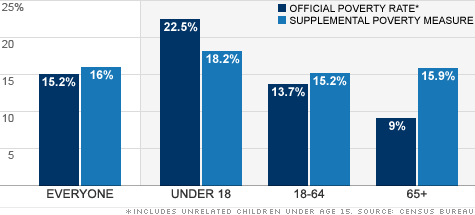
NEW YORK (CNNMoney) -- There were more than 49 million Americans living in poverty in 2010, under an alternative measure released by the Census Bureau Monday.
That's 16% of the nation, higher than the official poverty rate of 15.2%. The official rate, released in September, showed 46.6 million people living in poverty.
The Census Bureau's first supplemental poverty measure includes various government benefits and expenses not captured by the official poverty rate, which will continue to be used to determine eligibility for public assistance and federal funding distribution. The alternative calculation also takes into account geographic differences in prices.
Acting on recommendations from the National Academy of Sciences, the Census Bureau designed the new measure to capture the impact of many forms of non-cash public assistance, such as food stamps, housing subsidies and energy assistance.
"The main driving force behind this measure was to give policy makers a handle of the effectiveness of poverty [programs]," said Kathleen Short, an economist with the Census Bureau.
Non-cash government aid, as well as the earned income tax credit, lowered the poverty rate for recipients by as much as 2 percentage points.
Six temporary safety net programs that originated in the 2009 stimulus act helped keep 7 million people out of poverty, said Arloc Sherman, a senior researcher at the Center on Budget and Policy Priorities, citing the new Census report. These include three new or expanded tax credits, two enhancements of unemployment insurance, and expanded food stamp benefits.
The Census Bureau analysis shows how important it is to maintain the funding of these aid programs, which are currently facing the budget knife as Congress seeks to reduce the deficit, said Ron Haskins, senior fellow at The Brookings Institution.
"The lead story should be that government programs are effective in reducing poverty," Haskins said.
On the other hand, expenses such as income and payroll taxes, work-related expenses such as transportation and child care, and medical costs increased the poverty rate by as much as 3.3 percentage points.
Who is affected: The new measure had a major impact on poverty rates among the elderly, in part because they have large medical expenses. While Social Security keeps many of them just over the poverty line, health care costs can easily pull them under, Short said. Some 15.9% of senior citizens are considered poor, up from 9% under the official rate.
Fewer children, however, are living in poverty under the supplemental measure because they benefit from many government assistance programs and the earned income tax credit. The level drops to 18.2%, down from 22.5%.
The new measure found that energy assistance and the WIC health and nutrition program for women, infants and children had little impact on the poverty rate, decreasing it by only 0.1%. Child support payments also had a minimal effect, lowering the rate by the same amount.
Under the new measure, the poverty rate among blacks fell to 25.4%, down from 27.5%. But more whites, Asians and Hispanics are impoverished.
Renters experience a small drop in poverty, while homeowners see their poverty rates increase, regardless of whether they have a mortgage.
Where they live: Americans who live in metropolitan areas have higher poverty rates under the supplemental measure, while the opposite occurs for those who lives outside of them. That's partially because the new report adjusts for geographical differences in prices.
Likewise, the northeast and the west, which have higher living costs, see their poverty rates jump, while the midwest and the south find their rates drop a bit.
Under the new measure, the poverty threshold for a family with two adults and two children in 2010 was $24,343, while the official threshold is $22,113.
Both the official and supplemental measure show the impact of the Great Recession on the poor. The poverty rate soared to its highest level since 1993 under the official calculation. The supplemental measure, meanwhile, showed poverty increasing to 16% of the population, up from 15.3% in 2009.
When presenting the official poverty rate statistics on Monday, Census officials used a broader group than the official rates published in September. This week's data include unrelated individuals under age 15, which pushes up the figures slightly. ![]()
| Overnight Avg Rate | Latest | Change | Last Week |
|---|---|---|---|
| 30 yr fixed | 3.80% | 3.88% | |
| 15 yr fixed | 3.20% | 3.23% | |
| 5/1 ARM | 3.84% | 3.88% | |
| 30 yr refi | 3.82% | 3.93% | |
| 15 yr refi | 3.20% | 3.23% |
Today's featured rates:
| Latest Report | Next Update |
|---|---|
| Home prices | Aug 28 |
| Consumer confidence | Aug 28 |
| GDP | Aug 29 |
| Manufacturing (ISM) | Sept 4 |
| Jobs | Sept 7 |
| Inflation (CPI) | Sept 14 |
| Retail sales | Sept 14 |